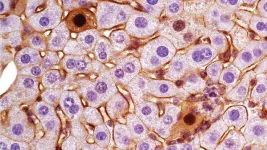(Press-News.org) LEXINGTON, Ky. (April 10, 2023) — University of Kentucky researchers are creating an innovative statewide surveillance system to inform prevention and response efforts aimed at reducing the burden of opioid use disorder in Kentucky.
The Rapid Actionable Data for Opioid Response in Kentucky (RADOR-KY) will use data from federal, state, and local sources to guide evidence-based practices aimed at preventing opioid overdoses in the Commonwealth. Phase one of the project is supported by a three-year $3.1 million grant from the National Institute on Drug Abuse (NIDA).
Driven by the COVID-19 pandemic and illegally manufactured fentanyl, drug overdose deaths in the U.S. increased to historic levels in 2021. Kentucky has been hit hard by the opioid epidemic. Overdose deaths reached an all-time high of 2,250, with 90% of those deaths involving an opioid.
Co-led by Svetla Slavova, Ph.D., associate professor in the College of Public Health, and Jeff Talbert, Ph.D., professor in the College of Medicine and College of Pharmacy, RADOR-KY will use a comprehensive set of data needed to effectively monitor and respond to the rapidly evolving opioid overdose crisis.
The system will use advanced algorithms to rapidly process data and help predict potential overdose surges using artificial intelligence.
“This unique, first-of-its-kind system will not only track and monitor overdose cases but use predictive analytics and dashboards for fast dissemination of analytical results to keep state agencies and local stakeholders on the frontlines of the opioid epidemic in Kentucky a step ahead,” said Slavova, who also serves as interim associate dean for research in the College of Public Health.
RADOR-KY will use data from multiple sources, including the Kentucky Office of Vital Statistics, syndromic surveillance, emergency medical services, prescription drug monitoring, Medicaid claims and drug seizure records. It will also track measures related to evidence-based practices such as treatment for opioid use disorder, overdose education and the distribution of naloxone, a life-saving medication that rapidly reverses an opioid overdose.
The project will leverage the expertise of UK research centers including the Kentucky Injury Prevention and Research Center, the Center on Drug and Alcohol Research, and the Institute for Biomedical Informatics. It also builds upon the expertise and experience gained from UK's work on the HEALing Communities Study (HCS).
“We’ve harnessed the power of our data processing capabilities at UK with the framework and experience gained from our work on the HEALing Communities Study, which has also shown that addressing this public health crisis requires working across disciplines,” said Talbert, who also directs the Institute for Biomedical Informatics.
“The HEALing Communities Study has been an exemplar of how a state and a university can work together and one of the deciding factors for receiving this award,” said HCS principal investigator Sharon Walsh, Ph.D., a professor in UK’s College of Medicine and College of Pharmacy and director for the Center on Drug and Alcohol Research.
Walsh leads the project’s substance use disorder team, which will advise on the content of evidence-based practices and state and local partners who are end users of the system.
Katherine Marks, Ph.D., a UK College of Medicine research assistant professor who serves as project director for the Kentucky Opioid Response Effort (KORE) within the Cabinet for Health and Family Services, is the project’s state government liaison.
Marks says RADOR-KY’s faster data processing, predictive analytics and inclusion of evidence-based practices will help the state take more strategic action.
“The opportunity for state and community partners to have readily available access to data so we can take action and evaluate how we’re doing in our response is a remarkable innovation,” said Marks. “This is a wonderful demonstration of the collaborative potential between the state and university expertise. It’s also yet another example of how UK is working as the University for Kentucky.”
An end-user advisory group, including partners in state government and local communities, will also guide the development of RADOR-KY. To advance the efforts to mitigate the opioid epidemic across the U.S. the team also plans to share programming code and algorithms in a public repository.
This project is supported by the National Institute on Drug Abuse of the National Institutes of Health under Award Number R01DA057605. The content is solely the responsibility of the authors and does not necessarily represent the official views of the National Institutes of Health.
As the state’s flagship, land-grant institution, the University of Kentucky exists to advance the Commonwealth. We do that by preparing the next generation of leaders — placing students at the heart of everything we do — and transforming the lives of Kentuckians through education, research and creative work, service and health care. We pride ourselves on being a catalyst for breakthroughs and a force for healing, a place where ingenuity unfolds. It's all made possible by our people — visionaries, disruptors and pioneers — who make up 200 academic programs, a $501 million research and development enterprise and a world-class medical center, all on one campus.
In 2022, UK was ranked by Forbes as one of the “Best Employers for New Grads” and named a “Diversity Champion” by INSIGHT into Diversity, a testament to our commitment to advance Kentucky and create a community of belonging for everyone. While our mission looks different in many ways than it did in 1865, the vision of service to our Commonwealth and the world remains the same. We are the University for Kentucky.
END
New UK data system will help predict and prevent opioid overdoses in Kentucky
2023-04-10
ELSE PRESS RELEASES FROM THIS DATE:
AACR announces recipients of the 2023 AACR June L. Biedler Prize for Cancer Journalism
2023-04-10
PHILADELPHIA – The American Association for Cancer Research (AACR) is pleased to announce the recipients of the 2023 AACR June L. Biedler Prize for Cancer Journalism in the following categories:
Auditory Journalism
“‘No Mercy’ Chapter 5: With Rural Hospital Gone, Cancer Care Means a Daylong Trek”
Sarah Jane Tribble (Photo), Taunya English (Photo), Kaiser Health News
Greg Munteanu (Photo), Saint Louis Public Radio
Magazine
“One Man’s Search for the DNA Data That Could Save His Life”
By ...
Identifying cancer genes’ multiple personalities
2023-04-10
Mutations in our genes can lead to severe problems, like colon or liver cancer. But cancer is very complex. Mutations in the same genes can lead to different subtypes of tumors in different people. Currently, scientists don’t have a good way to produce such tumor subtypes for study in the lab.
Now, Cold Spring Harbor Laboratory Assistant Professor Semir Beyaz has created a new method to model certain liver cancer tumor subtypes using the gene-editing tool CRISPR-Cas9.
Genes contain the information our bodies need to create proteins. Highly similar proteins produced from the same gene are called isoforms. Different isoforms generate ...
Recent advances in mushroom research
2023-04-10
So, mushroom-zombies recently took over a fictional world, but in real life, they’re really not so scary. These fungi range in shape from broad, plate-like portobellos and gangly enokis to a version resembling a giant, shaggy lion’s mane. And now scientists are finding ways to grow mushrooms on new materials, as well as incorporate them in more sustainable products. Below are some recent papers published in ACS journals that report insights into additional applications for mushrooms. Reporters can request free access to these ...
Giant, swimming mouths: Oral dimensions of extant sharks do not accurately predict body size in Dunkleosteus terrelli (Placodermi: Arthrodira)
2023-04-10
A new study by Case Western Reserve University PhD student Russell Engelman published in PeerJ Life & Environment attempts to address a persistent problem in paleontology – what were the size of Dunkleosteus and other late Devonian arthrodire placoderms. Arthrodire placoderms are extinct fishes with had armor covering their head and part of their torso, but like sharks the rest of their skeleton was made of cartilage, meaning most of their body did not preserve when they became fossilized.
Previous size estimates for Dunkleosteus were ...
Scheduled childbirth may greatly reduce preeclampsia, a leading cause of maternal death
2023-04-10
Research Highlights:
Analysis found that more than half of preeclampsia cases that occur during weeks 37-42 of pregnancy (called at-term preeclampsia) may be prevented with timed birth, such as a scheduled induction or Cesarean delivery.
Planned labor inductions and Cesarean deliveries are already widely practiced for a range of reasons, however, they are seldom considered as an intervention to prevent at-term preeclampsia, which may be life-threatening.
Embargoed until 4 a.m. CT/5 a.m. ET Monday, April 10, 2023
DALLAS, April ...
Non-biological factors and social determinants of health important in women’s CVD risk assessment
2023-04-10
Statement Highlights:
A new American Heart Association scientific statement reviews research about racial and ethnic differences in cardiovascular risk factors among women in the U.S.
In addition to traditional risk factors, women of underrepresented races or ethnicities experience challenges in the diagnosis and treatment of cardiovascular conditions due to language barriers, discrimination, difficulties in acculturation or assimilation, lack of financial resources or health insurance, or lack of access to health care.
Women of racial and ethnic backgrounds other than white have been underrepresented ...
Study finds record-breaking rates of sea-level rise along the U.S. Southeast and Gulf coasts
2023-04-10
Sea levels along the U.S. Southeast and Gulf coasts have been rapidly accelerating, reaching record-breaking rates over the past 12 years, according to a new study led by scientists at Tulane University.
In the study, published in Nature Communications, researchers said they had detected rates of sea-level rise of about a half an inch per year since 2010. They attribute the acceleration to the compounding effects of man-made climate change and natural climate variability.
“These rapid rates are unprecedented over at least the 20th century and they have been three times higher than the global average over the same period,” says Sönke ...
New guidelines on catatonia aim to create a step-change in management
2023-04-10
For the first time, the British Association for Psychopharmacology (BAP) has produced a guideline on catatonia. Catatonia is a severe psychiatric disorder that has been associated with a wide range of medical complications. Yet recognition and management remain poor.
Twenty-two experts from across three continents examined the latest research on this important condition and have developed a series of recommendations ranging from diagnosis and investigation to treatment. According to the lead author, Dr Jonathan Rogers of University ...
Targeted testing for HIV in hospital emergency departments has great potential, Spanish researchers say
2023-04-10
**Note: the release below is a special early release from the European Congress of Clinical Microbiology & Infectious Diseases (ECCMID 2023, Copenhagen, 15-18 April). Please credit the conference if you use this story**
Embargo: 2301H UK time Sunday 9 April
**Note – the press release is available in Spanish and Portuguese, see links below**
Targeted testing for HIV in emergency departments has great potential for increasing diagnoses, this year’s European Congress of Clinical Microbiology & Infectious Diseases (ECCMID) in Copenhagen, Denmark, (15-18 April), will ...
Engineered plants produce sex perfume to trick pests and replace pesticides
2023-04-10
By using precision gene engineering techniques, researchers at the Earlham Institute in Norwich have been able to turn tobacco plants into solar-powered factories for moth sex pheromones.
Critically, they’ve shown how the production of these molecules can be efficiently managed so as not to hamper normal plant growth.
Pheromones are complex chemicals produced and released by an organism as a means of communication. They allow members of the same species to send signals, which includes letting others know they’re looking for love.
Farmers can hang pheromone dispersers among their crops to mimic the signals ...


